Dimmer for LED lamps: types, how to choose, the best models on the market
Electricity is constantly rising in price, so more and more citizens are taking the issue of saving it seriously.As a result, a significant part of people in the post-Soviet space have already become acquainted with LED lamps.
But it turned out that their use is far from the limit of energy saving. Since a dimmer for LED lamps opens up even greater possibilities. In addition, the device has additional advantages.
The content of the article:
What is dimming?
Any electrical appliance only works if there is some kind of load, and it can be controlled. The regulation process itself is called dimming. This can also be done with LED lamps.
This procedure is performed with a device called a “dimmer”. It is this that can provide additional energy savings.

In addition, the presented device significantly expands the functionality of LED lamps. Which is also a significant plus.
What advantages does the regulator provide?
As stated above, dimming primarily reduces energy consumption. This reason is already enough to connect it to LED lamps in the home and any other premises. But there is a whole list of advantages.
These include:
- The ability to change the intensity of the glow provides owners with increased living comfort and helps make any interior individual and exclusive. So, for example, a room can be divided into separate zones using lighting. It will also be possible to change the brightness depending on the time of day and needs.
- Simulating the presence of owners in the premises - this option will be indispensable during vacations or business trips, which will make it easy to mislead burglars.
- Automatic switch-off/switch-off - modern dimmers can be programmed, in addition, they can be controlled by various external devices, for example, tablets, smartphones. There are special signaling devices that send commands to power drivers.
All kinds of preset lighting and blinking modes allow you to select the best options for any time of the day once and not waste time in the future. In addition, it is not only convenient, but also allows you to save more.
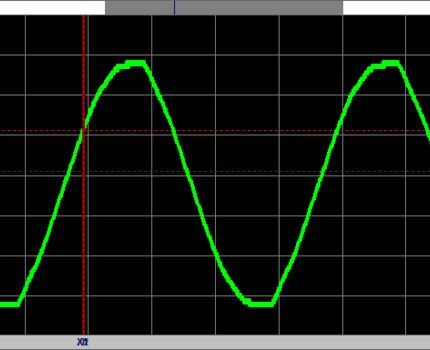
Remote control is also an important advantage. With its help, a person can regulate the voltage, and, consequently, the brightness of the glow, in various ways, for example, using a remote control, radio and sound signals (claps, voice).
At the same time, modern regulators themselves are durable and unpretentious. In addition, they are convenient to use.
You also need to know that with their help you can control LED lamps with familiar standard sockets, for example, they can be the familiar E27, E14, as well as many other popular and rare ones.This greatly simplifies the creation of the system.
It is also important that dimmers are able to control the glow of one lamp, several or even a whole group. They are resistant to overloads, are silent when the model is correctly selected, are light in weight, and are compact.
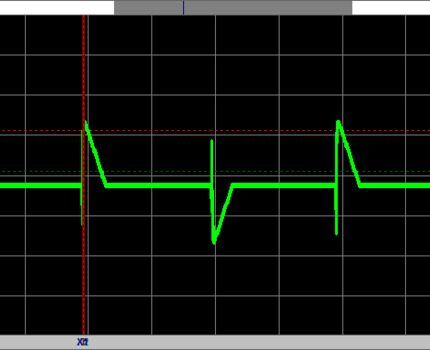
The cost of such equipment varies, so the interested consumer will be able to choose the optimal solution according to his budget, which will ensure the expected result.
Types of modern dimmers
Manufacturers supply the market with a large number of different equipment that can adjust the brightness of the light. Therefore, for convenience, it is divided into types.
First of all, devices are divided according to the type of control, which is as follows:
- Mechanical, sometimes called stationary.
- Electronic - like the previous option, it is a contact view. But instead of regulators and buttons, a sensor is used. This method is modern, effective, informative and quite expensive.
- Acoustic, that is, the brightness of the glow changes as a result of some kind of sound signal that exceeds the noise level set by the user or manufacturer.
- Wireless remote — the control panel familiar in other areas is also used here, as well as smartphones and tablets. In addition, various types of signals can be used, namely infrared, radio.
With a mechanical control method, the homeowner can adjust the brightness of the glow using a push or rotary control - a regulator, buttons, keys. It transmits a signal to a controller installed in the power line.
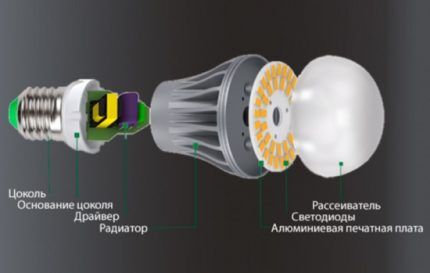
That is, the procedure is similar to using a regular switch. Some regulators even have controls in the form of familiar keys. This method is effective, simple, and accessible. The only relative disadvantage is the obsolescence of this option, which results in lack of prestige.
The electronic method, apart from being informative, has no other advantages over the mechanical one. But the modern display alone, indicating the necessary information, makes this option more modern and even prestigious, which is the reason for choosing it.

Acoustic dimmers are also a popular control method; in addition, they are affordable and reliable. A significant drawback is the limited modes. There are only a few of them and they are pre-installed. Therefore, it is not a fact that they are ideal for the user.
In addition, there is no guarantee that this option will work correctly, since its acoustic sensor will respond to any signal of sufficient power, and this will not always give the expected result.In this case, the user will not be able to constantly monitor the situation.
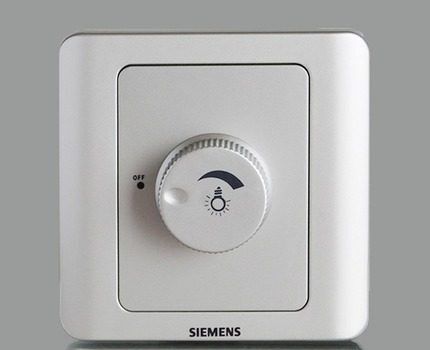
As mentioned above, a wireless remote method for controlling the brightness of LED lamps in a home involves the use of some kind of control panel capable of issuing the command:
- via radio channel;
- via infrared channel.
In the first case, control is possible from anywhere in the room, building, and even from outside. This option is practical and effective, but expensive, since such equipment costs a lot.
The infrared remote control also expands the user's capabilities, but requires pointing at the dimmer. Despite the relative disadvantage, this option is more popular - the equipment is more affordable.
In addition, transmission of commands using smartphones and tablets via Wi-Fi is also considered remote control. Often, such a system is also accompanied by a remote control, which increases convenience.
Today, the remote control method is the most functional, as it allows you to unlock your full potential. dimmers for LED strips, spotlights and regular lamps. Namely, it makes it possible to use energy as economically as possible and increase comfort to the expected level.
In addition, this option allows you to automatically or smoothly turn off/on the lights, simulate the presence of owners in the rooms, and perform any other functions available to regulators.
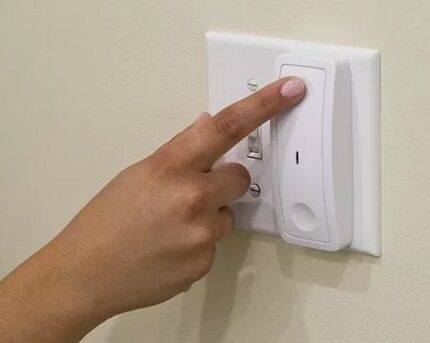
A potential buyer needs to know that today solutions are increasingly being used that can be controlled using several methods at once. This makes the procedure for adjusting the brightness of lamps more reliable and convenient. The only disadvantage of combined control systems is their considerable cost.
Additionally, all dimmers produced today can be divided according to the installation method.
Which are as follows:
- invoices — such devices are installed instead of conventional switches;
- built-in — they are mounted in a distribution box, a specially made niche;
- modular or panel boards - their place is on the DIN rail in the electrical panel room, but due to their functionality, performance and high cost, such residential devices are rarely used.
You should know that overhead models are the most popular due to their availability and ease of installation. Proven in practice ways to connect dimmers are given in our recommended article.
How does regulation happen?
Any dimmer is a device that is built in according to the principle of a traditional switch, familiar to all users, or instead of it.
The main condition is that it should be located before the LED lamp power driver, although in some cases this is no longer a mandatory parameter, but such a pleasure is expensive.
To a person unfamiliar with a dimmer, it may seem that it simply changes the voltage, as conventional regulators do, but this is not the case. Design dimmable LED lamps complex, the principle of their operation is somewhat different from the usual devices that illuminated the room with incandescence.
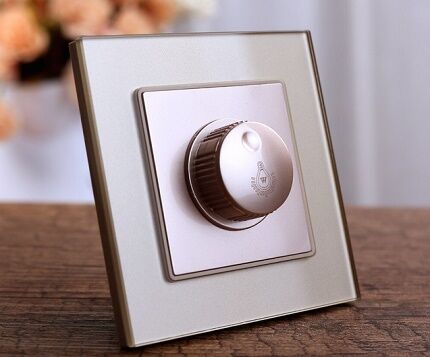
Since all LEDs operate in a narrow voltage range, even a slight decrease in voltage will lead to lighting fixtures blink, go out or don’t turn on at all.
To avoid this, dimmers make adjustments based not on the traditional principle of reducing the load supplied to the lamp, but on the use of pole-width modulation. With the help of which electric current is supplied in short pulses with relatively long pauses between them.
The described procedure is performed up to hundreds of times every second. Thus, any LED lamp can be made to stably illuminate the room at 10-100% of its capabilities.
What lamps can be used?
Every potential owner of a dimmer should remember that only special LED lamps that can be dimmed can be used with it.
They can be easily identified by the inscription “Dimmable” or the corresponding sign on the packaging. This condition is mandatory, since the use of conventional LED lamps will only lead to their frequent flickering, and a smooth glow cannot be achieved; if the voltage does not correspond to the specified voltage, then they simply do not turn on.
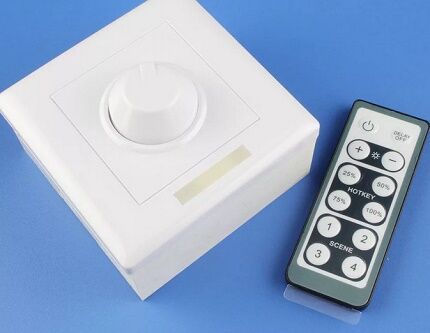
In addition, this kind of experiment will lead to rapid wear of the LED lamp or the dimmer itself and further failure.
Compatibility is always an issue
A consumer interested in using brightness control equipment should know that he will not only have to buy the necessary system components, but also match them together. Often there is a problem of inconsistency between the dimmer and the purchased LED lamp.
This happens due to the fact that there are a large number of electronic circuits for power drivers for lighting devices and control devices on the market.
Products of any domestic, European or Chinese manufacturer have the right to have a voltage threshold unique to them for inclusion. Also, incompatibility can lead to the fact that the range of adjustments is narrowed, and significantly.
For example, there are LED lighting devices that can turn on and operate even at 5% of the rated power. An incorrectly selected dimmer will only be able to control them within 40-100%. This will significantly reduce the functionality of the process.
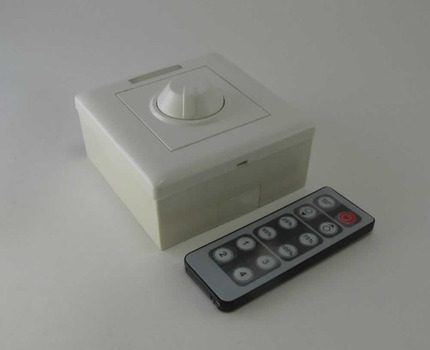
This feature will lead to the fact that the consumer will not save enough energy or will not be able to provide himself with the expected level of comfort. This is also a significant drawback. Other signs of malfunction may also appear.
The most common are the following:
- The power driver of the existing LED lamp makes loud sounds that are unpleasant to the user during operation or cannot start the lighting device.
- The maximum voltage at the output of the dimmer does not reach the required 220 Volts, which makes it impossible to use the light bulb at full power.
- Short-term bright flashes when the lighting device is turned on, the duration of which usually does not exceed 1 second.
- Various interruptions in the functioning of the regulator itself, which will not allow you to effectively control LED lamps.
All of the above points indicate that the selection of equipment should be done carefully and competently.
How to choose a dimmer and compatible lamps?
In order for the brightness regulator together with lighting devices to give the desired result, when choosing them, you need to take into account a number of points. Initially, a person needs to decide what he wants to get from dimming, whether it is possible to use it in the right room or building.
Next, they decide on the desired option for controlling the equipment - mechanical or remote, or perhaps it is better to use other methods. After resolving this issue, it is necessary to calculate whether the potential buyer is ready to pay the required amount of money.
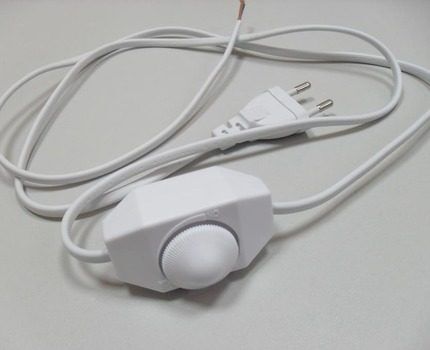
If all of the above steps are completed successfully, then you should proceed to the choosing a dimmer. In this case, a person must take into account its power. Why do you need to imagine how many lamps the device will control?
You also need to know exactly the power of each of them - by adding up all the values, the user will know what performance his dimmer should have. It is impossible to do without these calculations, because insufficient power will lead to the fact that the purchased regulator will immediately fail, and in the best case, it will simply not start.
In addition, if in the future it is possible to increase the number of lamps or their power, then when purchasing a regulator you need to take this into account, or the result will again be disastrous. Even if the owner of the premises does not plan to install an additional number of LED lamps, there should still be a power reserve. And no less than 20%.
It is best to create a safety margin of 50%. For example, if the total power of all lamps used is 100 W, then the same indicator for the brightness control should be at least 120 W, and optimally 150 W.
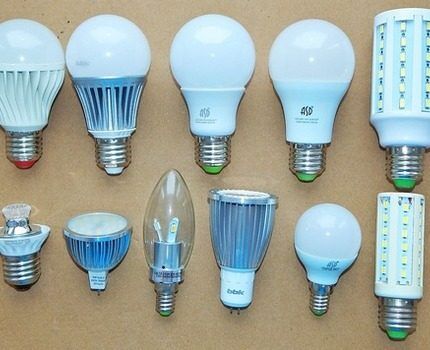
The power of LED computing lamps is easy to find out. All you need to do for this is look at the packaging, if the lighting fixture is new and it has been preserved. Otherwise, you need to carefully examine the LED lamps themselves, since most manufacturers indicate all the main characteristics on them.
When choosing a dimmer for more than one lighting fixture, keep in mind that their minimum power is 25-40 W. Therefore, when you plan to use several low-power LED lamps that collectively do not reach the specified values, you will have to install a suitable device for each of them separately.
When choosing a regulator, you should give preference to a product that can provide glow at a minimum level. The reason is that all LED lamps have sufficient brightness, so the dimmer will not be able to effectively reduce it, and the consumer, accordingly, will not get the maximum effect from using the device.

Before purchasing, a potential buyer should first of all pay attention to products from well-known manufacturers. This will ensure stability and quality for many years, although their cost is significantly higher than that of similar devices made in the Middle Kingdom by other little-known market participants.
Often, choosing an LED lamp and dimmer can only be done experimentally. As a result, it is initially necessary to install control equipment, and only then select lighting fixtures.
Moreover, you should find out from the seller whether it is possible to return the purchased LED lamp if it turns out to be incompatible with the dimmer. Lighting devices must also be produced by popular manufacturers, among which there are quite well-known names: Siemens, Osram, Philips, Gauss, Schneider Electric, A.S.D.LEGRAND Feron and others.
When purchasing LED lamps, Chinese companies should, in most cases, be ignored. Since, to reduce cost, they are equipped with low-quality crystals, the degradation of which will begin almost immediately after use.
As a result, this feature will lead to a significant dimming of the lighting and, if in a conventional lamp this is leveled out by the stability of the operating mode, then with regulation one can expect a clear deterioration in performance characteristics, which will reduce savings and comfort.

To reduce the likelihood of LED lamps being incompatible with the control device, the buyer should have some knowledge and carefully study the information provided by the manufacturer on the packaging.
Consultation with an experienced seller will be useful. Since the problem of incompatibility is relevant and specialists regularly encounter such cases, therefore they have a significant amount of knowledge. As a result, their opinion can be useful.
Conclusions and useful video on the topic
Rules for choosing a device for adjusting the brightness of lighting fixtures:
The following video provides an overview of a large number of dimmers:
This video clearly shows the effect of LED dimming:
It is not difficult to choose a dimmer for any manufactured 220 V LED lamps, but a potential buyer must have at least basic knowledge on this topic.
Otherwise, a person risks getting an unpredictable result that may not coincide with his expectations. That is, saving energy and increasing the comfort of living will not be effective, nor will it be possible to achieve other goals.
Tell us about how you selected and installed a dimmer for LED light bulbs. Share the criteria that influenced your personal choice.Please leave comments in the form below, post photos, and ask questions about the topic of the article.




In addition to LED lamps, our repairmen advised us to purchase a dimmer to save even more electricity, because there are many rooms in the house and, accordingly, there are many lamps. We have never regretted it, it really helps you save more. We chose a mechanical one - it’s quite simple to use, and once you get used to it, it’s convenient. And it is cheaper than, for example, electronic.
Our family tried to make friends with this newfangled thing. But, alas, love did not happen. We thought that we would really save electricity and pay for the dimmer itself, but in fact, after its introduction, diode light bulbs began to burn out more often. This is despite the fact that they are designed for several years of service. Maybe the dimmer was caught like that, who knows, but the decision was made not to experiment anymore.
Do you even buy dimmable LED lamps? Well, don’t hesitate to change the LEDs in the store if they burn out before the warranty period.
You asked a fairly simple question, but at the same time it is still relevant and for some reason the situation does not change. I know firsthand that people install dimmers, but at the same time leave ordinary LED lamps (read “it will do as is”). And then they wonder why their lamps started to burn out so often? The website even has article, which gives advice on choosing dimmable LED lamps - I advise you to read it.
If you want adjustable lighting, but don’t want to get involved in a serious modernization, then it’s easier to buy Wi-Fi lamps. The functionality is not quite the same, but it is quite convenient to control the lighting from a smartphone. The same Phillips has corresponding models. And only specially designed dimmable lamps will work correctly and without failures with a dimmer.